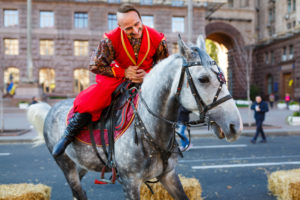
19 Jan 2022 The Ukrainian saddle horse, a melting pot of blood
An equine melting pot of breeds, the Ukrainian Saddle Horse’s origins may have their roots in Russia. Still, it can lay claim to the influences of Trakehner, Hanoverian, the English Thoroughbred, and mares from Hungary. Before the nascent breed’s evolution, however, breeders concentrated on using the stock of the Russian Saddle Horse to build its foundation.
A bit of history. Breeding of the Ukrainian Saddle Horse began after the Second World War at the stud farm, Dnipropetrovsk in central Ukraine, a part of the Soviet Union at the time expanding to eastern and southern Ukrainian stud farms. Deriving from cross-breeding over time, the origins of the Ukrainian Saddle Horse can be credited to two Russian counts in the 18th and 19th centuries, however.

Copyright Uladzislava Pratashchyk | Dreamstime.com
Count A.G. Orlov developed the first saddle breed in Russia at the end of the 18th century by producing two separate bloodlines with two stallions, one of which fathered the foundation sire of the Orlov Trotter. A century later, Count Rostopchin imported four Arab stallions and crossed them with the Karabakh, Kabarda, Persian, and Don mares. In 1845, a purchase of the Rostopchin stud mated its mares with Orlov stallions. The cross resulted in a new breed called Orlov-Rostopchin.
The First World War and the occupation of Ukraine decimated the Orlov-Rostopchin breed and almost eliminated it during the Second World War. Only two purebred stallions and one mare remained when the guns finally stopped.
Eight years of breeding and cross-breeding efforts proved successful when the Ukrainian Saddle Horse emerged. During the first stages of the breed’s rebirth, pure and half-bred Thoroughbreds, Arabs, and AkhalTeke horses supplemented the blood of the small number of Orlov-Rostopchin horses that remained. One part of the genetic code of Orlov-Rostopchin blood and blood from Trakehner, Hanoverian, and Thoroughbreds.
History is never straightforward!
Calm and easy to train, the Ukrainian saddle horse excels in multiple disciplines, including dressage, showjumping, and eventing. A closely controlled breed, only the best horses can stand at stud. Ukrainian Saddle Horses begin their training early, just before age two, and are evaluated in performance testing activities, including racing, dressage, and jumping.
The number of Ukrainian Saddle Horses registered in 2004 numbered 1,393 and were distributed between five state stud farms and twenty breeders. The total represented twenty-three percent of the total purebred breeds in the country of Ukraine and was only slightly below the Russian Trotter.

Copyright Castenoid | Dreamstime.com
The Ukrainian Saddle Horse exceeds in professional disciplines but is also a favorite in Ukrainian cultural events, including traditional Cossack trick riding, called jigitovka meaning “skillful and brave rider”). The annual Ukraine Cossacks Horse Show in Kyiv highlights the acrobatic skills and the cultural potency of these riders. The Ukraine Cossacks Horse Show coincides with Defenders of Ukraine Day and has been a public holiday celebrated every year since 2015.
The Ukrainian Saddle Horse may have complex beginnings but grew as a breed and the pride of a country that has always fought for its autonomy. Even now.
Stay tuned, stay healthy, and stay horsey.
Anna and D’arcy

